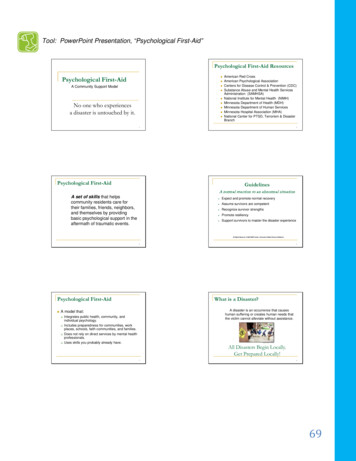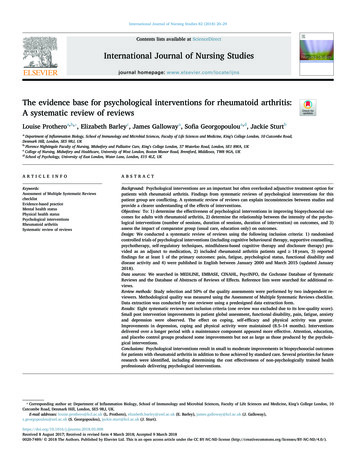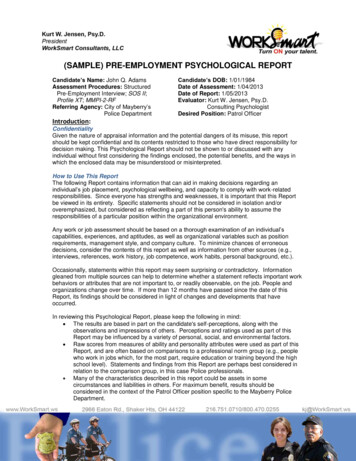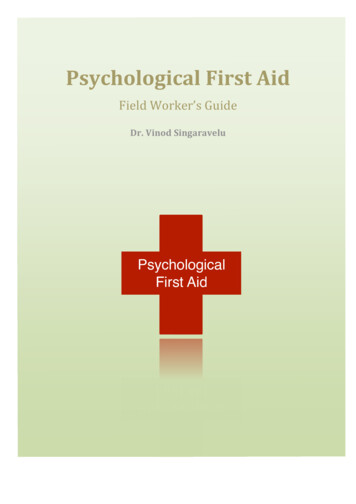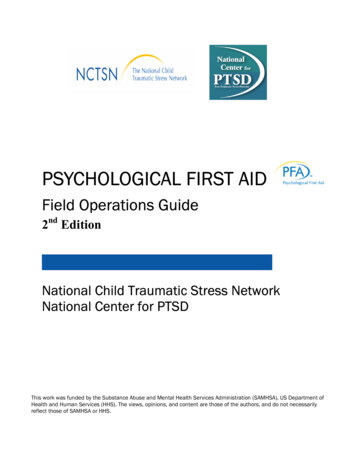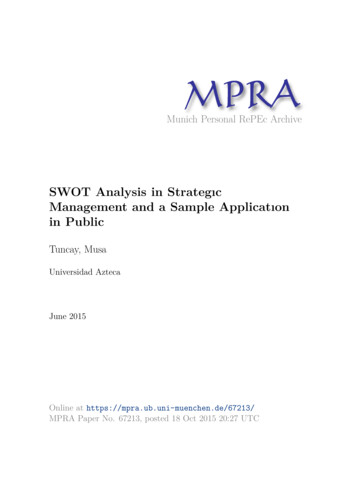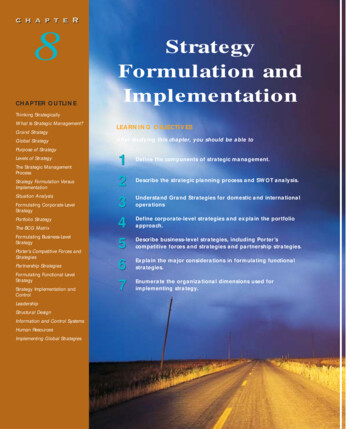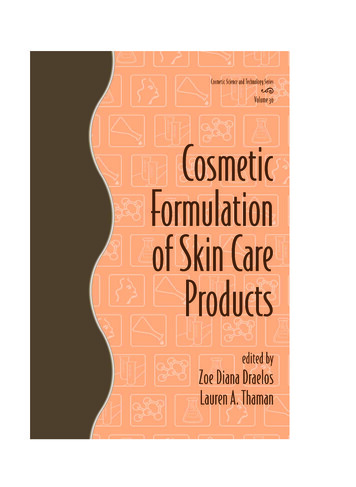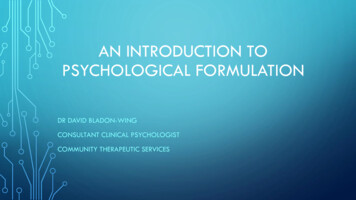
Transcription
AN INTRODUCTION TOPSYCHOLOGICAL FORMULATIONDR DAVID BLADON-WINGCONSULTANT CLINICAL PSYCHOLOGISTCOMMUNITY THERAPEUTIC SERVICES
CONTENT:PART 1. Definitions Single / Team Formulation Essential Features HCPC Standards Some Contentious IssuesPART 2. Some Models of Formulation Bio-Medical Cognitive Behavioural Therapy (5 P’s) structure Evaluation of Formulation
WHAT DO WE MEAN BY:‘PSYCHOLOGICAL FORMULATION’? Some definitions: Formulation is a provisional explanation or hypothesis of how an individual comes to present witha certain disorder or circumstance at a particular-point in time. (Weerasekera, 1996) A formulation is a tool used by clinicians to relate theory to practice . It is the lynchpin thatholds theory and practice together . Formulations can best be understood as a hypothesis to betested. (Butler, 1998) Formulation will draw on psychological theory and research to provide a framework fordescribing a client’s problems or needs, how it developed and is being maintained. (Division ofClinical Psychology, BPS, 2010)
AN EVOLVING WORKING DEFINITION: The Division of Clinical Psychology Good Practice Guidelines (DCP, 2011) Formulation summarizes and integrates a broad range of biopsychosocialcausal factors. It is based on personal meaning and constructed collaborativelywith service users and teams.
TEAM FORMULATION: ‘Formulation’, first appeared in clinical psychology publications in the 1950’s(Crellin, 1998). However, no single definition of ‘formulation’ currently exists. It is now widely used by many other mental health practitioners including,nurses, applied psychologist, psychotherapists and psychiatrists. A recent development is to use ‘formulation in teams’, in order to facilitate agroup or multi-disciplinary team of professionals to develop a sharedunderstanding of the service user’s difficulties.
TEAM FORMULATION: It has been suggested that using formulation in teamwork is a particularlyeffective way of achieving cultural change and promoting a more psychosocialperspective in services as a whole. (Kennedy et al., 2003) Taking formulation into a wider setting can be a powerful way of shiftingcultures towards a more psychosocial perspective. (Onyett, 2007)
THE ESSENTIAL FEATURES: Summarizes the service user’s core problems; Suggests how the service user’s difficulties may relate to one another, by drawing onpsychological theories and principles; Aims to explain, on the basis of psychological theory, the development and maintenance ofthe service user’s difficulties, at this time and in these situations; Indicates a plan of intervention which is based in the psychological processes and principlesalready identified; is open to revision and re-formulation. (Johnstone & Dallos, 2006)
PSYCHOLOGICAL FORMULATION: The Health Care and Professionals Council (HCPC), (2015). Standards of Proficiency for Practitioner Psychologists states that: .that formulation should be used to assist multidisciplinary working and communication, sharedwith service users to support an understanding of their experience, revised as necessary in light ofnew information, used to assist and plan interventions considering client perspectives and form partof a therapeutic cycle adhering to a scientist-practitioner model.Specifically .Practitioners (applied psychologists) must be able to formulate service users’ concernswithin chosen therapeutic models and to implement therapeutic or alternative interventionsappropriate to the presenting problem and to the psychological and social circumstances of theservice user.
SOME CONTENTIOUS ISSUES:
SOME CONTENTIOUS ISSUES:1. Whether formulation can be considered as fact or opinion?2. Are there common cohesive factors or irreconcilable differences acrosstherapeutic approaches to formulation?3.Who is included in the creation and sharing of formulations?
FACT OR OPINION
1. FACT OR OPINION: Some Questions: Can formulation ever be accurate, objective and factual, or if they alwaysremain a subjective account of a person’s experience, what external factors orbiases may influence those creating a formulation? This questions the validity of the scientist-practitioner model and the usefulnessof hypothesis testing.
1. FACT OR OPINION: Can a ‘formulation’ stand apart from the phenomenological or constructiviststance to human nature and enquiry? To what extent is our knowledge and understanding of mental disordersocially-constructed? To what extent should our formulations incorporate the cultural beliefs of ourclient (and us) or, does ‘mental disorder’ exist as an independent factor?
1. FACT OR OPINION: These are relevant themes, particularly if you hold a fundamental appreciationof the subjective, phenomenological experience of both the practitioner and theclient, and understand the philosophical concerns around notions of accuracy andobjective measure, (Ponterotto, 2005).
1. FACT OR OPINION: Does ‘accuracy’ matter, or rather should formulations be judged more on theirusefulness? There is evidence that the effectiveness of the various psychotherapeutictraditions, i.e. CBT, person-centered, psycho-dynamic, systemic, areconsiderably more effective if the client is also in agreement with thetherapeutic approach, regardless of which approach is chosen.
1. FACT OR OPINION: Is ‘formulation’ an event or process?Formulation has been described as either an ‘event’ or ‘process’, and questions thereforesurround which characterization is more appropriate or useful? Formulation as an event: can provide a definitive statement such as a diagnosis, whichprovides a more prescribed approach. However, it can only be a snap-shot in time. Formulation as a process: suggests that the relational aspects of the therapeutic relationshipinform a collaborative and evolving formulation, which is flexible and responsive to the client’sdeveloping and shifting processes.
1. FACT OR OPINION: An aspect of formulation relating to validity and representativeness regardsthe ‘when’, of when the formulation is undertaken. Antaki et al. (2005), describes formulation as an ongoing process within thetherapy room, which is constantly open to editing and reformulation. However,many practitioners may be required to create formulations after one or perhapstwo initial meetings.
1. FACT OR OPINION: Crellin (1998), argues that if the purpose of formulation is for ‘the client toarrive at a meaningful narrative’, the only true formulation can only be done atthe end of therapy, as this is when the full picture is revealed. This position, however, negates the use of formulation as a tool for assisting inintervention planning, turning it into more of a story of the client’s journey.
1. FACT OR OPINION: As previously discussed, an attempt to reconcile the afore-mentionedphilosophical criticisms of assessing formulations by their validity or accuracy,is to consider formulations in terms of their usefulness. The Division of Clinical Psychology Guidelines (DCP, 2011) states: .that one of the principles of formulation in clinical psychology is that this is best understoodin terms of ‘usefulness’ than ‘truth’, meaning that formulation is not an expert diagnosis orpronouncement, but rather a ‘plausible account’.
1. FACT OR OPINION: This raises a debate between the differences and complexities betweenformulation and diagnosis. There is also the question as to whom or for what should the formulation beuseful and whether it facilitates positive clinical change in the client?
COHESIVE OR DIVISIVE
2. COHESIVE OR DIVISIVE: Do the various theoretical approaches have unifying factors or are theyultimately irreconcilable and should, thus, always adhere to one theoretical orpsychological approach? Each major paradigm has addressed the use of formulation based upon theirtheoretical and philosophical structures. It is possible for various approaches to be integrated to create tailoredtherapies or ‘fusion theories’, or does this create philosophical conflict andconfusion?
2. COHESIVE OR DIVISIVE: Questions that may be helpfully asked: To what extent does the underpinning psychological theory and formulationencourage an expert or co-produced position? Can a service user easily understand the theoretical knowledge and engagein the co-construction of the formulation?
2. COHESIVE OR DIVISIVE: Do you adapt a generalist or specialist approach to psychological andformulation knowledge and practice? The Division of Clinical Psychology (DCP, 2011) has attempted, in its professional formulation guidelines, to reconcile the issues facingpluralistic or integrative practitioners. The guidelines note that, given the tendency fortherapeutic theories to draw upon and reflect each other to varying degrees, formulationwill share similarities regardless of approach.
2. COHESIVE OR DIVISIVE: Alternative stances arising from the literature attempted to createformulations based on more over-arching theories, such as the biopsychosocialmodel, or the widely used psychological approach of the ‘four (or five) P’s’model, or through a ‘common-language’ approach. The DCP (2011) guidelines state that whilst psychological theories such as thefour P’s (predisposing, precipitating, perpetuating and protective factors) orbiopsychosocial models utilize theory from several domains and considerfactors from several life sources, they often still lack personal meaning of theclient within them.
INCLUSIVE OR EXCLUSIVE
3. INCLUSIVE OR EXCLUSIVE: There is a fundamental question of who should be included in the developmentof a formulation. Much of the literature suggests that formulation should be collaborative withthe client. However, there is little if any research on whether this is beneficialor not to the client.
3. INCLUSIVE OR EXCLUSIVE: Redhill et al. (2015) was a qualitive research project looking at 10 clients. They also found that the emotional shift was not always positive for the client; withexperiences of distress regarding increased awareness of one’s difficulties and withbeing presented a formulation which does not match one’s self-identity or isperceived as inaccurately being reported. However, they went onto find that some of the distress was temporary and resolved;however, some was also enduring.They found that formulation helped some clients to understand their problems;leading to feeling accepted and understood; leading to an emotional shift; enablingthe client to move forward.
3. INCLUSIVE OR EXCLUSIVE: Pain et al. (2008) also investigated service user reactions to being presentedwith their formulations (n 13). Having examined the formulations, the clients revealed feeling far moremixed in their reactions including positive, negative and neutral reactions.Reactions varied from feeling sadness, relief, daunting or helpful, seeing themas having therapeutic value or as confusing.
3. INCLUSIVE OR EXCLUSIVE: In conclusion, despite mixed and narrow results from both these small-scale studies,positive reactions and effects cannot be assumed for clients sharing in the creationand experience of formulation. MacDonald and Mikes-Liu (2009) raise concerns as to whom the formulation is for; itseems that if for the therapist it is a clinical tool, then collaboration and sharing maynot be deemed necessary; however, if that tool guides interventions and it is to beshared with other professionals, ethical questions regarding the exclusion of the clientduring this process may be born (HCPC, 2016).
3. INCLUSIVE OR EXCLUSIVE: Barry et al. (2009) investigated how staff perceptions of service users may bemodified by discussing formulations regarding issues the staff were experiencing withindividual clients under the guidance of a clinical psychologist. While the results were positive, it is important to note that the study only measuredstaff perceptions not behavior towards the service user. The study suggested that enabling staff to see alternative psychological ways ofviewing the service user’s experiences can in some circumstances positively effecttheir experience of this side of the relationship.
3. INCLUSIVE OR EXCLUSIVE: Team Formulation: This idea of being open to alternative ways of viewing a client regarding formulation isdemonstrated in the concept of multidisciplinary or team formulations.Johnstone, (2014) proposes that team formulations bring several benefits: they canenable varied inputs across practitioners and professions so that therapists canincorporate a broad range of theories and be less likely to miss important factors; itcan enhance work with complex clients; challenge myths about service users; helpstaff to manage risk and raise moral. However, the usual problems of professionalpower, opposing opinions and personality clashes, as well as, practical problems ofarranging meetings will always exist.
3. INCLUSIVE OR EXCLUSIVE: The HCPC (2015) states that formulation should be used to assist multidisciplinary team working and communication with West et al. (2012)suggesting that decisions made by mental health teams of this nature are of‘higher quality’ than teams consisting of single-profession members orindividuals alone.
3. INCLUSIVE OR EXCLUSIVE: Christofides, Johnstone and Musa (2012), found that clinical practitionersvalue input from others in their professional teams, and that this is oftenundertaken in an informal manner, in casual conversations as opposed toformally planned meetings with this purpose in-mind. Overall, the authorsstate that it appeared that sharing information regarding clients in thismanner was beneficial to client work and team cohesion.
SOME MODELS OF FORMULATION
SOME MODELS OF FORMULATION: Bio-Medical Model The Cognitive-Behavioural Model: (4 (or 5) P’s)
THE BIO-MEDICAL MODEL
MEDICAL MODEL: Psychiatric diagnosis is deeply embedded in practice, research and clinicalgovernance, as well as in other areas of public life such as the criminal justicesystem and the benefits system. NICE recommendations and most outcome measures are diagnostically-based,and a diagnosable mental illness is a pre-requisite for access to mental healthservices.
MEDICAL MODEL: Mental disorder is embedded in the same paradigm of disease and physical illness. Presenting Symptoms Biological Signs or Markers Diagnosis Prognosis Treatment
BIO-MEDICAL MODEL: I was trained to employ local diagnoses .and it still strikes me as strange thatthe case histories I write should read like short stories and that, as one might say,they lack the serious imprint of science .Case histories of this kind have,however, one advantage, namely an intimate connection between the story of thepatient’s sufferings and the symptoms of his illness. (Freud & Breuer, 1895)
BIO-MEDICAL MODEL: There are very few disorders whose definition was a result of specific researchdata For borderline personality disorder there was some research that lookedat different ways of defining the disorder. And we chose the definition thatseemed most valid. But for the other categories rarely could you say that therewas research literature supporting the definition’s validity. Dr Robert Spitzer, 2013, (who led the team of psychiatrists who developedDSM III )
MEDICAL MODEL: (Royal College of Psychiatrists, 2010) Psychiatric formulation as described in the curriculum is based on the description ofthe various biological, psychological and social factors involved in the predispositionto, the onset of and the maintenance of common psychiatric disorders.Formulation features in the curriculum for psychiatrists’ training in the UK.The Curriculum for Specialist Core Training in Psychiatry (Royal College ofPsychiatrists, 2010) requires trainee psychiatrists to demonstrate the ability toconstruct formulations of patients’ problems that include appropriate differentialdiagnoses.
THE COGNITIVE-BEHAVIOURAL MODEL
THE CBT MODEL: The core model of CBT is defined in collaboration with the service user as partof the assessment process in terms of:EmotionsThoughtsBehaviours
THE CBT MODEL: CBT is based on the simple idea that how we view ourselves, the world and thefuture shapes, and is shaped by, our emotions, thoughts and behaviours.SelfWorldFuture
THE CBT MODEL: Case Formulation in Cognitive-Behavioural Therapy: Case formulation is described as the ‘lynchpin’ of Cognitive-BehaviouralTherapy (CBT). (Butler, 1998) Formulation is seen as one of the key elements of CBT (Beck, 2011)
5 P’S MODEL: It is suggested that a framework for CBT formulation that helps link theperson’s experiences to the cognitive model using the 5 Ps:1.2.3.4.5.Presenting ive.
1. PRESENTING ISSUES: This process compliments psychiatric diagnosis in that we begin to define thecurrent problems the person faces. This introduces the specific and individualization. We also define short, medium and long-term goals that can helpfullyidentify the end point of therapy. There is a focus on developing the therapeutic relationship through sharedunderstanding, clarifying problems and installing hope.
1. PRESENTING ISSUES: Despite the initial focus on current problems and goals, CBT is also interestedin the developmental origins of the difficulties. An initial assessment would normally include relevant background and contextto the presenting issues (onset of the problem, family, education, occupationaland psychiatric history, personal and social resources), which allows for a morein-depth understanding.
1. PRESENTING ISSUES: As we establish the nature of the presenting problems, we can start to agreeon the order and prioritize. We can also begin to explore whether the presenting problem-behaviours aretriggered by internal, external or a combination of events that are embeddedin time and place.
1. PRESENTING ISSUES:Presenting Problems:difficulty concentrating,problemsattendingwork, feeling lonely,not arranging to meetfriends, not answeringthe phone, not sleeping.Feeling: SadSituation: Spilt CoffeeThoughts: I cannot doanything right, I am uselessThecognitivemodelemphasizes that it is notthe events themselves, buta person’s view of theevents, that explains theirreactionBehaviours: Go to bed
2. PERPETUATING FACTORS: Although the initial descriptive model is a useful heuristic device it does notreally explain what maintains the issues in the long-term. Hence, we draw uponan expanded model that articulates the relationship between the elementsand helps to show the reinforcing nature of the problems. In such a model, the direction of the arrows is important, and the initial phaseof therapy must provide a defensible rationale for the links betweencomponents. This model often includes more explicit information about the physiologicalresponses to a situation.
2. PERPETUATING FACTORS:Presenting Problems:difficulty concentrating,problemsattendingwork, feeling lonely, notarrangingtomeetfriends, not answeringthe phone, not sleeping.Situation: Spilt CoffeeThoughts: I cannot doanything right, I am uselessFeeling: SadBehaviours: Go to bedPhysiology: Tearful
2. PERPETUATING FACTORS: Within CBT there is an increasing emphasis on understanding the specific andkey features unique to each different disorder. However, there are severalcore cognitive and behavioural mechanisms that are common to a range ofdifferent types of psychopathology (Harvey et al., 2004). These include various forms of emotional and behavioural avoidance,attentional processes such as vigilance for threat, and cognitive processes likerumination and worry (Dudley et al., 2010)
2. PERPETUATING FACTORS:Presenting Problems:difficulty concentrating,problemsattendingwork, feeling lonely, notarranging to meetfriends, not answeringthe phone, not sleeping.Situation: Spilt CoffeeThoughts: I cannot doanything right, I am uselessBy avoiding going to work the personmay confirm a view of him or herselfas ‘useless’. Avoiding situations canalso lead to a loss of rewardingbehaviours and thus help to maintainproblems like feeling sad (depression)Behaviours: Go to bed,avoid going to workFeeling: SadPhysiology: Tearful
3. PRECIPITATING FACTORS: Exploring and establishing the maintenance factors involved helps us to betterunderstand the presenting problems. However, we may still be unclear whatled to the onset of the difficulties. We introduce the notion of a longitudinal or historical formulation thatidentifies precipitant (setting conditions) or triggers to the onset of thedifficulties. These typically turn out to be particularly stressful events in time and place.
3. PRECIPITATING FACTORS: The Quantity of Stressors: Stress-Vulnerability models help us to understand that weare all susceptible to stressors in our lives and our vulnerability specifies the point atwhich we can no longer function or cope. The Quality of Stressors: Precipitating factors trigger access to a deeply seatedview of oneself (core beliefs or schema) that was learned through formativedevelopmental experiences. For example, a person may see her or himself as fundamentally unlovable and ineffectual (corebelief) owing to early experiences of abuse and/or neglect.
3. PRECIPITATING FACTORS:Triggering Event: the end ofan intimate relationship.Situation: Spilt CoffeeCore Belief: I am unlovable, I am useless.Conditional Belief: if I am in arelationship, then I am ok.Thoughts: I cannot doanything right, I am uselessCompensatory Strategy: Work hard toavoid relationship endingBehaviours: Go to bed,avoid going to workFeeling: SadPhysiology: Tearful
4. PREDISPOSING FACTORS: The Quantity of Historical Events: We have long understood that there is acumulative effect of trauma. The earlier its onset and frequency duringdevelopment the more potentially detrimental the effect. The Quality of Historical Events: the nature (physical, sexual, psychological)and severity of the trauma or negative psychosocial abuse the moredamaging. Adverse Childhood Experiences (ACEs) and the effects on physical and psychologicalhealth.
4. PREDISPOSING FACTORS:Triggering Event: the end ofan intimate relationship.Developmental Experiences:abandoned by biologicalparents. Raised by a series offoster parents and careinstitutions.Situation: Spilt CoffeeCore Belief: I am unlovable, I am useless.Conditional Belief: if I am in arelationship, then I am ok.Thoughts: I cannot doanything right, I am uselessCompensatory Strategy: Work hard toavoid relationship endingBehaviours: Go to bed,avoid going to workFeeling: SadPhysiology: Tearful
5. PROTECTIVE FACTORS: A Focus on Protective Resources: Supportive adoptive Mother and SisterGood friendGood job, reasonably well paidInterest in sportsGood sense of humor
5. PROTECTIVE FACTORS: Include the service user’s strengths and conceptualize resilience. Goals may include not just reducing distress but increasing strengths orpositive values (eg. To enjoy more time with your friends). Develop additional and alternative coping strategies. Enquire about cultural values or identity that can serve as a source of strength.
4. PREDISPOSING FACTORS:Presenting Problems:difficulty concentrating, problems attending work, feeling lonely, not arranging to meet friends, not answering the phone, not sleeping.Triggering Event: the end ofan intimate relationship.Developmental Experiences:abandoned by biologicalparents. Raised by a series offoster parents and careinstitutions.Situation: Spilt CoffeeCore Belief: I am unlovable, I am useless.Conditional Belief: if I am in arelationship, then I am ok.Thoughts: I cannot doanything right, I am uselessCompensatory Strategy: Work hard toavoid relationship endingBehaviours: Go to bed,avoid going to workFeeling: SadPhysiology: TearfulProtective Factors: supportive Mother & Sister, good friend, good job, likes sport, good sense of humour
SOME TESTS FOR A GOOD FORMULATION: Does it make theoretical sense? Does it fit with the evidence? Does it account for predisposing,precipitating and perpetuating factors? Do others think it fits? Can it be used to make predictions? Can you work out how to test thesepredictions? Does the past-history fit? Does treatment based on the formulationprogress as would be expectedtheoretically? Can it be used to identify future sources ofrisk or difficulties for the person? Are there important factors leftunexplained? (Butler, 1998)
THANK YOU Contact details:Dr David Bladon-Wing,Consultant Clinical Psychologist,Community Therapeutic Services.Primary Reference:Formulation in Psychology and Psychotherapy (Johnstone & Dallos). Routledge
TEAM FORMULATION: ‘Formulation’, first appeared in clinical psychology publications in the 1950’s (Crellin, 1998). However, no single definition of ‘formulation’ currently exists. It is now widely used by many other mental health practitioners including, nurses, applied psychologist, psychotherapists and psychiatrists.

